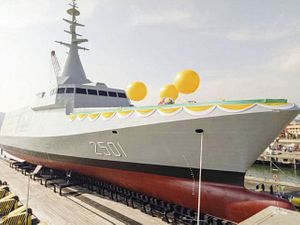Last week, Malaysia named and launched its first littoral combat ship (LCS) on order for its navy. The development is just the latest step the Southeast Asian state is taking to modernize its navy in spite of the significant challenges that remain.
As I have noted before, despite ongoing budgetary challenges, the Royal Malaysian Navy (RMN) is currently continuing the country’s modernization efforts (See: “What Does Malaysia’s New Defense Budget For 2016 Mean?”). One of the ways in which it is doing so is through the 15-to-5 Armada Transformation Program, which would see a reduction of the country’s current 15 classes of vessels, which average 30 years in age and are sourced from seven different countries, to just five categories: Littoral Mission Ships (LMS); Multi-Support Ships (MRSS); Littoral Combat Ships (LCS); New Generation Patrol Vessels; and submarines.
With respect to the LCS, Malaysia has ordered six new vessels under a 9 billion ringgit ($2.2 billion) contract awarded to Boustead Naval Shipyard (BNS) back in July 2014 (See: “Where are Malaysia’s New Warships in its Military Modernization?”). According to RMN specifications, the 3,000-ton LCS platform has a length of 111 meters and is based on the Gowind 2500 corvette designed by French shipbuilder DCNS. The keel for the first LCS was laid down in March 2016, and the one for the second vessel was laid down by Deputy Defense Minister Johari Baharum in March 2017.
On August 24, Malaysia launched the first LCS at a ceremony in the Boustead Naval Shipyard (BNS) facility in Lumut. The ceremony was attended by Malaysian officials and other dignitaries including Malaysian Defense Minister Hishammuddin Hussein, RMN Chief Admiral Kamarulzaman Ahmad Badaruddin, the Sultan of Perak Nazrin Muizzudin Shah, and Queen of Perak Zara Salim. The LCS, which was given the pennant number 2501, will be called the KD Maharaja Lela, named after the 19th century anti-British Malay nationalist who was executed by the colonial government in 1877.
The launch of the KD Maharaja Lela came ahead of the schedule originally announced by Malaysian defense officials, a point that Boustead Heavy Industries Corporation Berhad (BHIC) Executive Deputy Chairman and Managing Director Ahmad Ramli Mohamad Nor was keen to point out in his remarks. Hishammuddin emphasized that the vessels would enhance the RMN’s ability to protect the country’s sovereignty, especially in the face of the growing threat from the Islamic State (See: “What’s Behind Malaysia’s Latest Mass Terror Raid?”).
Unsurprisingly, he did not delve into the country’s other more delicate maritime challenges, including one posed by China in the South China Sea (See: “Malaysia’s South China Sea Policy: Playing it Safe”). He did, however, offer an update regarding progress being made on the delivery of littoral mission vessels (LMS) that Malaysia had agreed to buy from China, indicating that, based on the progress made thus far, the first LMS vessel would be received by October 2019 (See: “Malaysia’s New China Warships Deal: Promises and Prospects”).
The other five LCS, which will also be built in Lumut, are estimated to be fully delivered to the RMN by 2023, according to recent Malaysian government estimates.

































